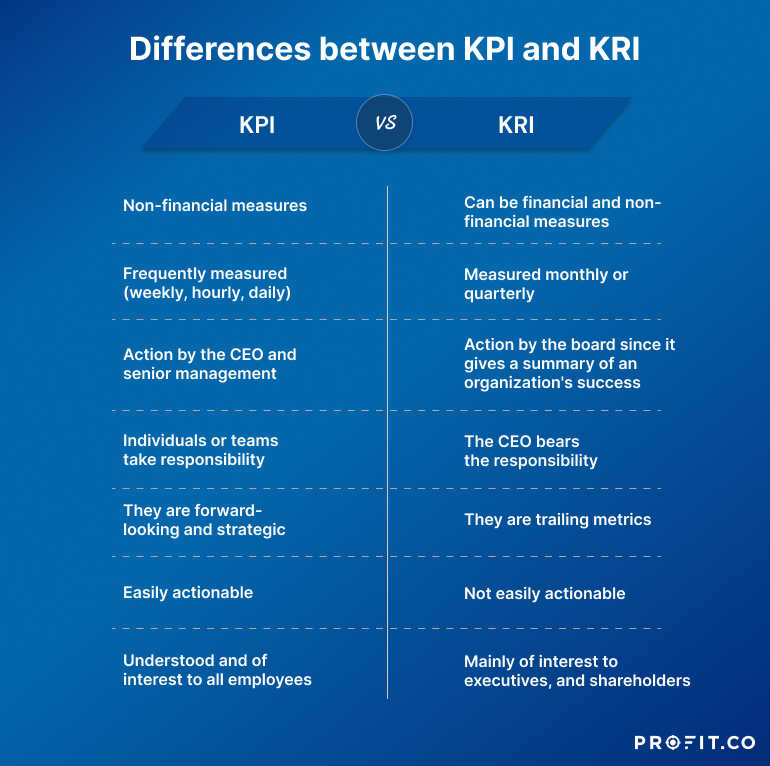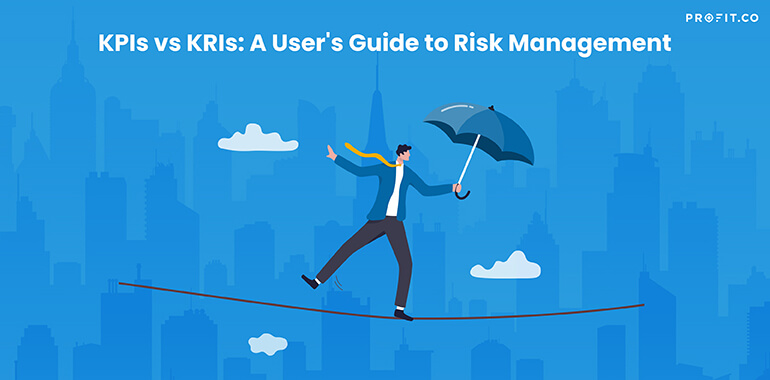Business success vastly depends on a clear understanding of objectives, strategy, and goals, properly tracking and analyzing them. Businesses use measurable indicators like KPI and KRI to achieve sustainable success, which provides data. Without data, we are all just talking words. Data helps to compare, analyze, prepare and plan in a successful organization.
Introduction to KPI
KPIs (Key Performance Indicators) are tracking and decision-making instruments that address your organization’s primary performance concerns once you’ve determined your strategic goals. This way, carefully crafted KPIs serve as essential navigational tools, providing a concise picture of overall current performance and determining whether the business is on track or not.
Organizations rely on KPI tools to assess how well people, businesses, projects, and organizations perform concerning their strategic goals. Key performance indicators are forward-looking and strategic. They measure the direct results of executive-level strategic decisions.KPIs reduce the complexity of organizational performance to measurable key indicators that help with decision-making and, eventually, performance improvement.
Want to get started on an intuitive and agile performance management software today? Start your free trial of Profit.co!
Ready to start your OKR Journey for FREE?
Introduction to KRI
KRI (Key Risk Indicators) is a metric risk indicator. Organizations use KRIs to assess the level of risk exposure or the riskiness of a specific project or activity. According to Rassoul Ghaznavi Zadeh, KRIs are a way to measure and keep track of the most significant risks an enterprise is subject to. They provide early warning signs. Organizations can build detection systems that let them track, manage, and mitigate substantial risks by evaluating risks and their prospective impact on firm performance.
Successful KRIs aid in
- Determine the early onset of greatest dangers
- Calculate the severity of these risks
- Introspect risks by offering benchmarks and comparisons
- Enable consistent risk monitoring and reporting
- Inform influential individuals as risks develop
- Aiding others in risk management and risk reduction
Examples
According to Bright Metrics, KRIs are trailing indicators. They measure business outcomes after the event has happened. An example of a KRI is reviewing revenue. Evaluating your business revenue would entail looking at numbers derived from aggregate data from the past. Other KRIs include financial and customer metrics like customer satisfaction and profitability.
Organizations might have a similar set of KRIs, but their KPIs differ depending on their strategic goals and interests.
For an electronics manufacturer whose strategic goal is to develop new products for the existing customers.
- You can use the percentage of recent product design wins per customer as a measure of KPI
- Other KPIs include customer/membership growth, net worth growth, market share growth, net interest margin/rate, and return on average assets,
While there are many possible KPIs the KRI in the above example is the risk of losing customers.
Risk comes from not knowing what you’re doing.
KPI vs KRI
We can use KRIs to quantify the risk in a business. Dundas states that Key Results Indicators (KRIs) provide information about these goals and objectives and their achievement status.
KRIs are general company updates that will inform you of whether or not things are proceeding as expected. KRIs assist organizations in understanding the risks associated and the probability of not delivering positive results in the future, while KPIs assist organizations in understanding their progress regarding their strategic plans. As a result, KRIs may be the opposite of KPIs.
Similarities between KPI and KRI
Key Performance Indicators and Key Risk Indicators are essential to the success of any business. Key Performance Indicators highlight the actions that build up to meet strategic results. They lead a company towards measuring its vital risk indicators.
Differences between KPI and KRI

What is the role of KPIs and KRIs in risk management?
Business managers must understand the connection between risk and performance by linking KRIs to KPIs. KRIs are critical to the achievement of goals and risk tolerance.
Linking KRIs and KPIs facilitates cross-functional cooperation and the incorporation of risk factors into business decisions. Gaining business support for the investment in risk mitigation measures is another benefit of linking KRIs to KPIs.
KPIs and KRIs help in risk management by
- Enabling a better comprehension of an organization’s performance and risk environment
- Giving stakeholders high-quality, meaningful information
- Incorporating risk parameters into strategic business decisions
- Enhancing enterprise risk management and corporate governance
- Creating a common language for talking about risk and performance
FAQs on KPI vs KRI
KPI vs KRI: Are KRI and KPI the same?
No. Key performance indicators and key risk indicators are not the same.
What is the purpose of KRI?
The purpose of a Key risk indicator is to assess the risk exposure level of a business or organization and thereby prevent loss.
What are KRI examples?
Examples of KRIs include financial metrics like financial statements and customer satisfaction data.
How do you measure KRI?
You can measure KRIs by assessing risks and their prospective impact on firm performance.
Conclusion
When developing KPI and KRI, it’s necessary to understand the organization and map both the external and internal environment to organizational objectives and goals. To mitigate against unnecessary risk exposure, organizations must develop sound Key Performance Indicators and Key Risk Indicators. They also help increase business performance. While these are good tools to measure the health of a business, challenges stem from inaction. Acting on the results helps create a successful and healthy business. Book a free demo with our team to learn more about how performance management software can improve your business!

